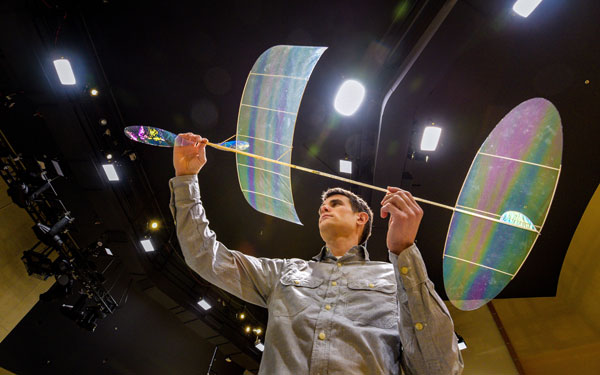Sandian holds two world records flying model aircraft

Releasing the gossamer-winged aircraft, Brett Sanborn loses control. All he can do after it gently leaves his grasp is watch, hoping it doesn’t collide with anything or get snagged by a patch of cool air as it slowly climbs, flattens out, circles and then descends.
If he’s done it right, it will be a successful flight of his indoor rubber-powered model aircraft. And Brett has done it right many times — including two world-record and world-championship times.
“You can mechanically preprogram some of the flight, mainly programming for a big circle,” says Brett, an environment mechanical engineer at Sandia. “After you let it go, you really don’t have any control.”
Light, lean and slow
Brett holds two world records for F1D models of indoor rubber-powered aircraft, fragile lightweight flyers with the fuselage, tail boom, wing, stabilizer and rudder constructed from balsa wood and reinforced in different places with boron fibers. The wing, stabilizer and rudder are covered with ultrathin Mylar, 0.5 micrometers, giving the aircraft a near-transparent look. The idea is to make it as light as possible but no lighter than the minimum-allowed 1.4 grams, about a half gram more than a U.S. dollar bill weighs. Wingspans are limited to 55 centimeters (21.65 inches), wing chords to 20 centimeters (7.87 inches) and horizontal stabilizers to 45 centimeters (17.72 inches).
“Of course, the idea is to get as close to that as possible,” Brett says. “Construction of one model takes on the order of 40-50 hours.”
A rubber motor has a separate weight requirement of a maximum of 0.4 grams. Before flight, he winds the rubber about 1,300 turns. The flight is launched by hand from the floor, flies at a speed of 2-3 feet per second, with the propeller turning at 50 revolutions per minute. In comparison, a typical passenger car will idle between 600 to 1,000 rpm.
“The propeller turns throughout the entire flight. There is no glide time,” Brett says. “Improvements in flight time are gained by better matching the rubber motor properties — thickness, length, total turns, torque — and adjusting the propeller — high and low pitch settings, diameter, pitch transition timing.”
Twice in the last two years, Brett has matched these properties better than anyone else before him.
Records and championships
On Sept. 3, 2017, Brett flew his craft for 32 minutes, 9 seconds, eclipsing the previous record for a flight above 100 feet by about 2.5 minutes. At Hanger 1 in Lakehurst, New Jersey, famous for being the crash site of the Hindenburg, he launched the world-record flight from the floor and the tiny aircraft climbed for 10 minutes to just below the rafters at roughly 165 feet. A slight drift pushed the model toward a wall, but the plane continued to cruise for 10-11 minutes before descending and claiming the record.
To watch this on YouTube, click here:
Brett’s second world record came on March 22 at the F1D World Championships in the 1901 atrium of the West Baden Springs Hotel in Indiana. Competitors had six rounds over three days, with the best two flight times added together for a total. The top totals of three competitors from a country are added together for the team championship.
Rounds 1-3 were plagued by bad weather. Snow on the roof and cool conditions inside caused thermals at different spots, Brett says. “The model would get caught in a thermal and climb to the top in less than two minutes. A half circle and about three minutes later, the model would be on the floor due to sinking air.”
The sun shone during round four, heating the roof and air. Brett seized the opportunity and pulled out his best plane and flew it for 27 minutes, 11 seconds, the longest time in the championship and a new world record for ceiling heights under 100 feet.
“Unfortunately, one needs to fly two consistently good times to win rather than having a single long flight,” Brett says. “With only a five-minute flight on the board as my backup, I wasn’t even on the podium.”
Competitors from Romania and Hungary were ahead on the leaderboard. Brett’s fifth-round flight — using his backup plane due to cold weather in the morning — failed to climb to the ceiling, drifted toward a wall and crashed with a time of only 18 minutes.
It came down to the final round. The team gathered and strategized. Brett, with the best chance at an individual title, would fly his best plane and be the last of the team to launch during the warmer afternoon.
Brett’s flight eased to its apex in about nine minutes, cruised about 1 foot below the atrium’s steel girders and then methodically descended. It landed 27 minutes, 1 second after it had taken off.
Brett claimed the championship, with a total time more than six minutes longer than the second-place Hungarian. Better yet, his teammates had also improved their flight times in the last round and would individually place fifth and sixth, catapulting Team USA to the championship with a total time nearly 20 minutes longer than second place Romania.
“Taking home the individual world champion title as well as the team world champion title is the best result the U.S. could have hoped for,” Brett says.
It’s about science
Brett started flying rubber-powered models when he entered a Science Olympiad at his Michigan high school. Those first flights would last three to five minutes.
“Science was always an interest,” he says.
He continued to fly throughout college and while earning his master’s in aerospace engineering from Purdue University in 2011. He’s been at Sandia since 2015.
In 2020, he plans to defend his titles at the world championship in Romania, which will be held in a 200-foot tall cathedral-shaped hall built underground in a salt mine.
“It will be a constant 50 degrees,” he says. “It’s way worse for rubber energy, but we’ll be ready.”